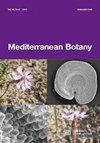Annual weedy species of Erigeron in the northern Iberian Peninsula: a review
IF 0.7
4区 生物学
Q3 PLANT SCIENCES
引用次数: 2
Abstract
A revision of the alien Erigeron L. species formerly included in Conyza Less. found in the central-northern Iberian Peninsula is presented. A close examination of numerous specimens collected by the authors as well as voucher specimens preserved at several herbaria has helped clarify several aspects regarding this group. Four species have been recognised in the study area: Erigeron canadensis (=Conyza canadensis), E. bonariensis (=C. bonariensis), E. sumatrensis (=C. sumatrensis) and E. floribundus (=C. floribunda, including C. bilbaoana). They occupy anthropogenic habitats, such as road edges, abandoned fields, crops and waste ground, as well as natural and semi-natural communities, such as nitrophilous river bar communities and ruderal communities on coastal dunes subjected to substantial levels of anthropogenic disturbance. Erigeron sumatrensis and E. floribundus emerge as the two most frequent taxa. Erigeron canadensis, regarded in the past as the most widespread species of the group, is almost absent from the study area, especially from the Atlantic watershed. Furthermore, an important number of specimens previously identified as E. bonariensis do actually correspond to E. sumatrensis. No hybrids have been found. A detailed identification key highlighting the main features that help to separate the four Erigeron species is presented. Finally, as E. floribundus is the most controversial species in the group and the last to arrive, a study of its expansion across western Europe in the last century is included, where it has become a frequent alien especially along the Atlantic regions.伊比利亚半岛北部飞蓬属一年生杂草种类综述
对以前列入《小稻》的外来飞蓬属植物进行了修订。发现于伊比利亚半岛中北部。对作者收集的大量标本以及几个标本馆保存的凭证标本进行了仔细检查,有助于澄清这一群体的几个方面。研究区内已确认四个物种:加拿大飞蓬(=加拿大稻)、博纳里E.博纳里E.(=博纳里E.)、苏门答腊E.(=苏门答腊C.)和花叶E.floribundus(=花叶C.floribunda,包括比尔鲍安娜C.bilboana)。它们占据了人为栖息地,如道路边缘、废弃的田地、作物和荒地,以及自然和半自然群落,如受大量人为干扰的嗜氮河坝群落和海岸沙丘上的粗鲁群落。苏门答腊飞蓬和花叶飞蓬是最常见的两个类群。加拿大飞蓬在过去被认为是该类群中分布最广的物种,但在研究区域,尤其是大西洋流域,几乎没有出现。此外,之前被鉴定为博纳里E.bonariensis的大量标本实际上与苏门答腊E.sumatrensis相对应。没有发现杂交种。介绍了一个详细的鉴定钥匙,突出了有助于分离四种飞蓬的主要特征。最后,由于E.floribundus是该种群中最具争议的物种,也是最后一个到达的物种,因此对其上世纪在西欧扩张的研究也包括在内,在那里,它已经成为一种常见的外来物种,尤其是在大西洋地区。
本文章由计算机程序翻译,如有差异,请以英文原文为准。
求助全文
约1分钟内获得全文
求助全文
来源期刊

Mediterranean Botany
Agricultural and Biological Sciences-Plant Science
CiteScore
2.40
自引率
10.00%
发文量
30
审稿时长
12 weeks
期刊介绍:
Mediterranean Botany (ISSNe 2603-9109), formerly Lazaroa, is a biannual journal that publishes original research studies in the field of Botany including plant systematics, vegetation ecology, biogeography, evolutionary biology, ecophysiology, community ecology, ethnobotany and conservation biology on Mediterranean biomes but also in interacting areas.
Mediterranean Botany is an OPEN ACCESS Journal, free of charges for any published article.
 求助内容:
求助内容: 应助结果提醒方式:
应助结果提醒方式:


